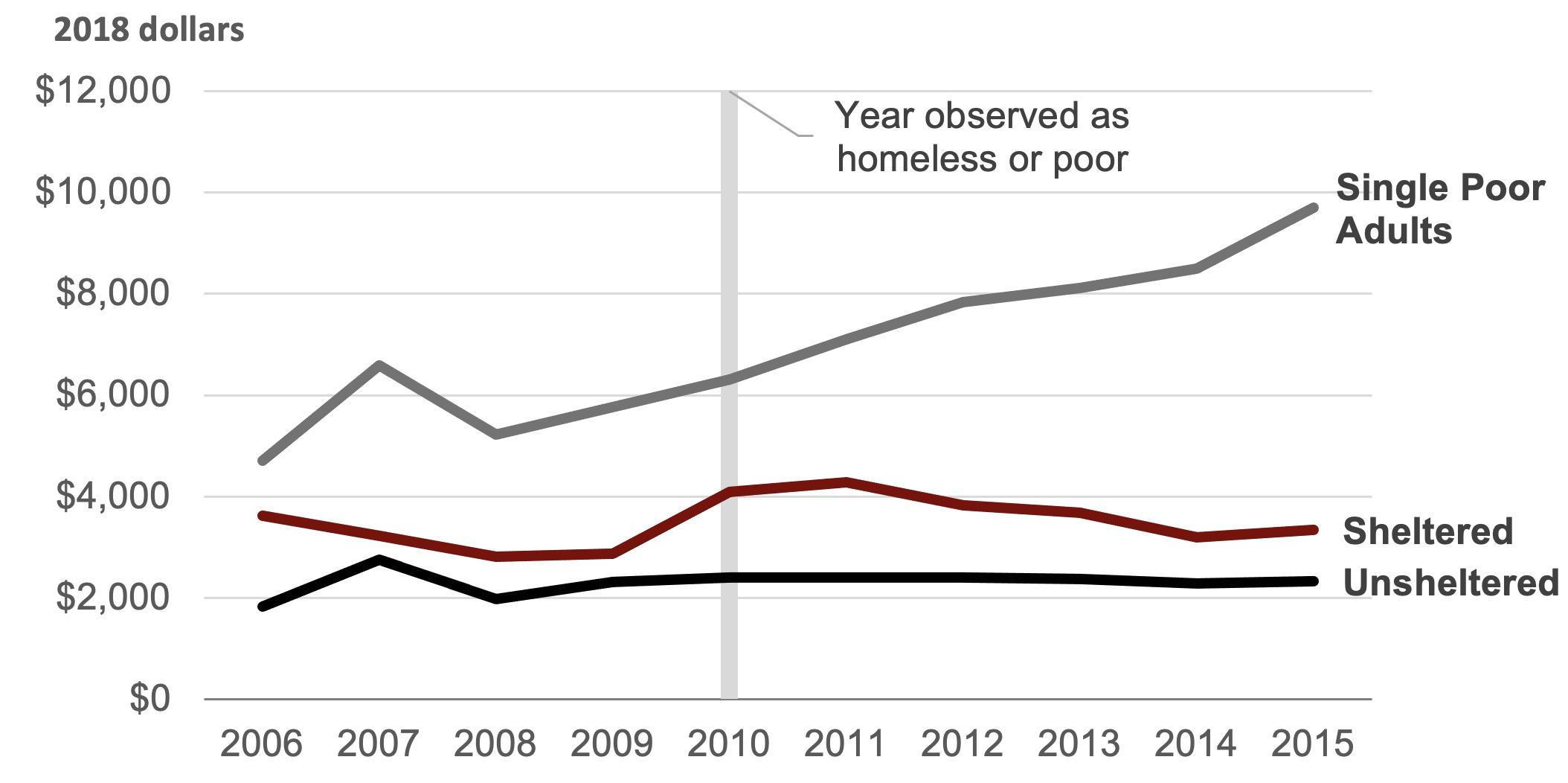On a single night in January 2020, over half a million people were estimated to be homeless in the US, including over 200,000 people who slept unsheltered on sidewalks, in public parks, and other places not intended for human habitation (HUD 2021). Despite ongoing concern from policymakers and the public, we know relatively little about this highly vulnerable population. Answers to fundamental questions such as how many people experience homelessness on a given night, the level of deprivation homeless people face, how frequently they move, and their mortality patterns are generally based on inaccurate and incomplete data. For example, the most recent nationwide survey of the homeless population was conducted 25 years ago and relied on self-reported information (Burt et al. 1999). And while communities now conduct annual counts of their homeless populations, estimates are deemed unreliable due to reliance on volunteers with little or no training (O’Flaherty 2019, US Government Accountability Office 2020). Some recent studies use administrative data in specific cities or contexts to examine the effects of policies on homelessness, but they are unable to answer questions about the overall US homeless population (e.g. Evans et al. 2016, Fetzer et al. 2020).
The barriers to collecting data on the homeless population are formidable. By definition, people experiencing homelessness are not housed, and thus are out of scope for most household surveys. This means that the homeless population is excluded from estimates of the US official poverty rate as well as most research that focuses on extreme poverty in the US. Indeed, our focus on homelessness was motivated by our recent research assessing extreme poverty in the US using surveys linked to administrative data, which necessarily excluded the homeless (Meyer et al. 2021a). The hole in our knowledge about some of the most deprived members of society is problematic for those wishing to understand poverty in the US.
A new dataset
Given the dearth of existing data to study the US homeless population, we created a new dataset that overcomes many of the limitations of previous efforts. We first identify people experiencing homelessness at a point in time at the end of March 2010, based on the US Census Bureau’s special effort to count people experiencing homelessness as part of that year’s Census. We link those homeless individuals to a large set of administrative data sources, including tax filings that capture earnings and other income sources, administrative government programme data that capture government benefits, and other data sources such as the universe of mortality records in the US and historical shelter use data from select cities. This linked dataset not only allows us to study the deprivation faced by people while they are homeless, but also in the years before and after we observe them as homeless in 2010.
We build on our findings from the linked Decennial Census data with the American Community Survey (ACS), which includes a random sample of the sheltered homeless population each year. Because homeless individuals are not identified as homeless in the public-use version of the ACS data, this survey has rarely before been used to study homelessness. In ongoing work, we link the ACS data covering the sheltered homeless population with the administrative tax and government programme data described above to form a second novel dataset. This dataset allows for analysis of sheltered homeless individuals in an extended number of years (2006–2016), has additional information about characteristics like inter-state mobility and functional limitations, and allows us to study transitions between homelessness and other housing statuses when linking each year of the ACS to the 2010 Decennial Census.
New findings on homelessness
Our data allow us for the first time ever to accurately measure the economic circumstances of the US homeless population, including earnings and employment, income, coverage by safety net programs, and deprivation experienced over the course of more than a decade. In our first paper using these new datasets, we find that 53% of sheltered and 40% of unsheltered homeless adults under age 65 had formal earnings in 2010, suggesting higher rates of employment than the public discourse often suggests (Meyer et al. 2021b). Even these rates may understate employment if some homeless individuals instead work off the books and thus receive earnings not captured on tax forms. We also find that the vast majority of homeless individuals receive government benefits. We find that 89% of sheltered homeless adults under 65 and 78% of unsheltered homelessness adults under 65 received benefits from at least one of Supplemental Nutrition Assistance Program (SNAP), Veterans benefits, housing assistance, Medicare or Medicaid at some point in 2010.
While homeless individuals have higher rates of employment and coverage by the safety net than often thought, they do not see improvements in economic wellbeing over time. In Figure 1, we show median pre-tax income plus the value of in-kind transfers received for both homeless adults and a comparison group of single poor adults. While the income of single poor adults rises over time, the income of both sheltered and unsheltered homeless adults remains low and stagnant. People who experience homelessness are not just having a difficult year. They are having a difficult decade.
Figure 1 Median pre-tax income and in-kind transfers of homeless and poor adults (age 18-64 in 2010)
Sources: 2010 Decennial Census, U.S. Census Bureau 2010 American Community Survey 1-year data, 2019 Numident, 2003-2016 IRS 1040 Datasets, 2006-2016 W2 Datasets, 2006-2016 IRS 1099R Datasets, 2004-2016 HUD PIC & TRACS, 2007-2014 Administrative VA Dataset, 2006-2014 Medicare Datasets, 2007-2015 Medicaid dataset, SNAP datasets for Illinois (2009-2016), Indiana (2004-2016), New York (2007-2016), New Jersey (2007-2016), and Tennessee (2004-2016).
Note: Sheltered and unsheltered homeless groups are identified in the 2010 Decennial Census, and the single poor adult group is drawn from the 2010 ACS. Unsheltered group includes individuals enumerated at soup kitchens and regularly scheduled mobile food vans. Pretax income and in-kind transfers are calculated as in Meyer et al. (2021b). Dollars are expressed as C-CPI-U adjusted 2018 dollars. For more information on confidentiality protection, sampling error, non-sampling error, and definitions in the ACS, visit www.census.gov/acs. All results were approved for release by the Census Bureau, authorization numbers CBDRB-FY20-ERD002-007 and CBDRB-FY21-045.
We additionally use our linked data to study other characteristics of the homeless population beyond their economic deprivation. Using answers to survey questions in the ACS, we find that 91% of sheltered homeless adults under 65 live in the same state in which they lived a year prior to the interview. And 56% of sheltered homeless adults under 65 live in the same state in which they were born, similar to the rate among a comparison group of housed individuals. Thus, migration among homeless individuals appears less prevalent than sometimes suggested. We also find relatively high rates of disabilities among the homeless population. For example, 24% of sheltered homeless adults under age 65 report difficulty remembering or making decisions, twice the rate among a comparison group of non-homeless poor individuals.
Future research
We plan to use our linked data to study a number of other important questions about the homeless population. For example, in one project in progress, we compare estimates of the homeless population derived from widely cited volunteer-led counts conducted each year with estimates from the 2010 Decennial Census and annual estimates of the sheltered population in the ACS. By uncovering the reasons for differences between the volunteer-led estimates and the Census and ACS-based estimates, our research will inform the accuracy of currently relied upon estimates of the size of the homeless population. This research is particularly relevant in light of growing concerns about current methods for estimating the size of the homeless population. Such concerns were highlighted in a 2020 Government Accountability Office report and have been accentuated by the difficulty of conducting counts during the COVID-19 pandemic. Other future projects will focus on mortality patterns, as well as transitions between homelessness, housing and correctional facilities.
Our research on homelessness is one component of a broader initiative called the Comprehensive Income Dataset (CID) Project, which aims to create the most accurate dataset on economic well-being ever created for the United States (Medalia et al. 2019). The CID combines household survey data from the Census Bureau with an unprecedented set of administrative tax and government program data to better measure economic well-being. We conduct rigorous research and rely on empirical evidence to ground our decisions about how to combine data sources and how to construct our income measures. Ultimately, we hope to provide researchers, policymakers and the public a highly accurate understanding of economic wellbeing in the US – one that includes the most vulnerable members of society.
References
Burt, M R, L Y Aron, T Douglas, J Valente, E Lee, and Britta Iwen (1999), “Homelessness: Programs and the people they serve: Findings of the national survey of homeless assistance providers and clients”, Urban Institute.
Evans, W N, J X Sullivan, and M Wallskog (2016), “The impact of homelessness prevention programs on homelessness.” Science 353(6300): 694-699.
Fetzer, T, S Sen, and P Souza (2020), “Housing insecurity, homelessness, and populism: Evidence from the UK”, VoxEU.org, 27 February.
GAO – US Government Accountability Office (2020), “Homelessness: Better HUD oversight of data collection could improve estimates of homeless population”, GAO-20-433, July.
HUD – US Department of Housing and Urban Development (2021), “The 2020 annual homeless assessment report (AHAR) to congress. Part 1: Point-in-time estimates of homelessness.”
Medalia, C, B D Meyer, A B O’Hara, and D Wu (2019), “Linking survey and administrative data to measure income, inequality, and mobility”, International Journal of Population Data Science 4(1): 1-8.
Meyer, B D, D Wu, V R Mooers, and C Medalia (2021a), “The Use and Misuse of Income Data and Extreme Poverty in the United States”, Journal of Labor Economics 39(S1): S5-S58.
Meyer, B D, A Wyse, A Grunwaldt, C Medalia, and D Wu (2021b), “Learning about homelessness using linked survey and administrative data”, NBER Working Paper 28861.
O’Flaherty, B (2019), “Homelessness research: A guide for economists (and friends)”, Journal of Housing Economics 44: 1-25.







